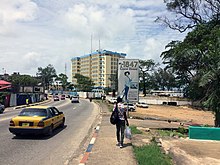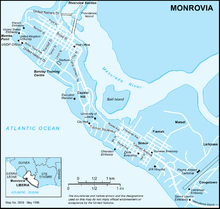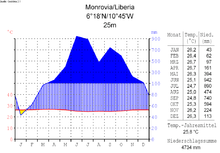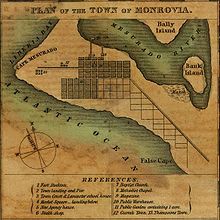Monrovia
| Monrovia | ||
|---|---|---|
|
|
||
| Coordinates | 6 ° 19 ′ N , 10 ° 48 ′ W | |
| Basic data | ||
| Country | Liberia | |
| Montserrado | ||
| ISO 3166-2 | LR-MO | |
| Residents | 970,824 (2008) | |
| politics | ||
| mayor | Mary Broh | |
|
A street in Monrovia with the former Hotel Ducor
|
||
Monrovia [ mɔnˈroːvi̯a ] is the capital of the West African state of Liberia . According to the census from 2008, it has 970,824 inhabitants.
geography
Monrovia is located on the southern branch of the mouth of the Saint Paul River in the Atlantic , in an area that was once bought from Sierra Leone , near Cape Mesurado . About 40 percent of the official urban area is taken up by the marshy mangrove forest of the Mesurado River , this area, which was previously considered a wasteland, is designated as an area worthy of protection by international nature conservation authorities, and urbanization pressure is increasing due to the slums known as shanty towns .
climate
In Monrovia there is an official weather station and the seat of the state meteorological service. The in equatorial Liberia located has a moist, tropical hot climate with an annual average temperature of 25.8 ° C. On the coast 24 ° C to 27 ° C, in the interior 22 ° C to 28 ° C are measured.
The dry season is characterized by low rainfall, during this time of year the country is under the influence of dry winds sweeping in from the southern Sahara , which in Liberia are called harmattan .
The rainy season is characterized by abundant rainfall, in Robertsport (northwest coast) the average rainfall is 5210 mm, in the "drier" south-east near Harper only 2500 mm. During this time, the road network in the hinterland often collapses for weeks.
history
The area was already inhabited when it was called Cape Mesurado by Portuguese sailors in the 1560s. The first settlers from the United States under the auspices of the American Colonization Society arrived in Africa in 1821. They landed on Sherbro Island in what is now Sierra Leone. The landing was not very successful and many settlers died. In 1822 a second ship rescued the remaining settlers and took them to Cape Mesurado, where the Christopolis settlement was built. As an unofficial holiday since 1823, December 1st has been celebrated in Monrovia as "Mathilda Newport Day".
In 1824 the city was renamed Monrovia to honor the then US President and first chairman of the American Colonization Society, James Monroe . The planned developed settlement was laid out on the model of American cities on the north side of Capitol Hill. The first port of Monrovia was located in the estuary of the Mesurado River, there was a shipyard in the Slipway district , warehouses and commercial establishments (coffee roasters) lined the bank, and Fort Stockton was built on the summit of Capitol Hill . Monrovia was reserved for the Ameriko-Liberians, the slaves freed from the navy in West African waters were settled in their own settlement Congo Town and were used there to build sugar cane plantations. From 1850 steamships with greater draft replaced the traditional sailing ships, but these could no longer call at the previous port and had to be anchored off the coast and loaded and unloaded with the help of boats. The Kru-Boys specialized in this business, on the headland under the lighthouse a separate New Kru Town district was built, now inhabited by fishermen .
As early as 1839 the Monrovia Seminary , founded by the Methodist Church , was the headmaster and later bishop of the Methodist Church of Liberia, AP Camphor expanded this institution to the West Africa College , he is considered the founder of vocational training in Liberia. The Liberia College is the forerunner of the University of Monrovia and was opened in 1862, in 1881 the future president was Edward Wilmot Blyden rector of this school. The city, then the only one in the republic, had about 13,000 inhabitants and was by far the most important trading center of the state and the seat of a German consul. At the end of the 19th century, Monrovia had a moderate harbor closed by a bar and consisted of only the smallest part of stone buildings, the rest of huts.
On July 26, 1947, the 100-year celebration (Centennial Celebration) for the foundation of the state was celebrated in Monrovia. The city saw a military parade and a demonstration by a US Air Force aerobatic team. On the occasion of the celebrations, the Centennial Pavilion and several buildings were inaugurated, the first Liberian national exhibition opened and Duke Ellington congratulated him with the Liberian Suite .
Since the 1990s, the quality of life in Monrovia has been badly affected by the ruinous civil war .
City administration
Acting mayor is Mary Broh , who replaced Ophelia Hoff-Saytumah in July 2009 , who fell because of a corruption affair .
Economy and Infrastructure
The city's economic mainstay is the seaport , which was significantly expanded by the US Army during the Second World War . The main export goods are rubber and iron ore . The port is also the location of large warehouses and shipyards . The industrial image of the city ranges from cement production to oil refining, food production, brick and furniture production, to chemical production.
The Ducor Hotel of the InterContinental Hotels Group is now in ruins, it was one of the most prominent hotels in West Africa . The capital's second luxury hotel - the Hotel Africa at the mouth of the Saint Paul River - is now in ruins. The Mount Coffee Dam was Liberia's first hydropower plant and was commissioned in 1966 to supply the capital and the port facilities. During the civil war, the insurgents succeeded in interrupting the power supply several times and destroying the generator block. A restart still fails due to the procurement costs of the technical systems, for which around 383 million US dollars were estimated.
power supply
The construction of the energy supply network in Monrovia began in the 1940s; it was initially restricted to the coastal region, where the industrial and port facilities, administrative and commercial facilities, hospitals and hotels were available as reliable customers. The Mount Coffee hydropower plant was commissioned in 1966 but was destroyed in the civil war in 1990.
The infrastructure was damaged during the civil war and the new construction was delayed. The Liberian government is currently looking for ways to rebuild the infrastructure with the help of the international community.
Road and rail network
The original street network of the city of Monrovia was laid out based on the American model and consists of a checkerboard grid of streets. The permanently emerging outskirts of the city, on the other hand, have a modified road network, there are paved roads in the vicinity of the administrative centers and industrial areas, but the majority of the suburban roads are natural roads and slopes.
The Somalia Drive is the main bypass road for the city region, but now this road is itself blocked by a high density of traffic. The Dakar-Lagos Highway is the most important trunk road and land connection to the neighboring West African states, but the road is only rudimentary in Liberia, an approximately 100 kilometer long section (Ganta-Tappita-Tobli border with Ivory Coast) is missing. The loss of the Mesurado Bridge is particularly fatal .
On December 30, 2011, the Tubman Bridge over the Saint Paul River was reopened.
air traffic
The Roberts International Airport is the international airport of Monrovia. Direct flights to and from Europe are currently (2017) offered by KLM and Royal Air Maroc. There are still connections to neighboring West African capitals offered by African airlines.
Educational institutions
- The state University of Liberia , founded in 1863, is the largest university in the country and is located in Monrovia. The university has the only law faculty in the country.
- Another educational institution that was finally closed in 2000 was the College of West Africa (CWA) in Monrovia. His role was taken over by the JJ Roberts United Methodist School (JJRUMS).
- Stella Maris Polytechnic, a college run by the Catholic Archdiocese of Monrovia .
Healthcare
The country's most important clinics and hospitals are located in Monrovia. To support the Liberian doctors and international aid organizations, naval hospital ships from NATO countries arrive in Monrovia several times a year.
additional
- White Plains Water Treatment Plant - the Greater Monrovia region's waterworks
- Antoinette Tubman Stadium
- Samuel Kanyon Doe Sports Complex , stadium in the Paynesville neighborhood
- Seaview Golf Club
- Palm Grove Cemetery
At Paynesville near Monrovia there was a longitudinal wave transmitting antenna of the OMEGA navigation system . The 417 m high steel frame mast was the tallest structure in Africa until it was blown up on May 12, 2011.
Diplomatic missions
Due to its pro-Western stance, Liberia has experienced a lot of rejection in African states, so only a few African states have established diplomatic relations with Liberia. During the civil war, almost all diplomats left the country for security reasons and are reluctant to return. The embassies of the Federal Republic of Germany , Switzerland and Austria were evacuated to Accra . In 2005, Germany was the first EU country to send an ambassador to Liberia again, which enabled the German embassy in Monrovia to reopen. The imposing building of the Swedish embassy is one of the few skyscrapers in the city that survived from the prewar period without major damage.
sons and daughters of the town
- Charles DB King (1875–1961), politician and President of Liberia from 1920 to 1930
- Antoinette Tubman (1914–2011), wife of the politician William S. Tubman and First Lady (1943–1971)
- Roland H. Cooper (* 1916), diplomat
- Ernest Eastman (1927-2011), Diplomat and Secretary of State (1983-1986)
- Ellen Johnson Sirleaf (* 1938), President of Liberia and Nobel Peace Prize Laureate
- George H. Johnson (born 1938), track and field athlete, Olympic participant (1956 and 1960)
- Boimah Fahnbulleh (* 1949), politician and diplomat
- Milton Nathaniel Barnes (* 1954), UN ambassador
- Sedia Massaquoi Bangoura (* 1957), diplomat
- Antoinette Sayeh (* 1958), Acting Africa Director at the International Monetary Fund (IMF), previously Liberia's Finance Minister
- George Cramne (* 1960), Swedish boxer
- Monie Ralph Captan (* 1962), Lebanese-Liberian politician and foreign minister (1996-2003)
- Simon Thirgood (1962–2009), British ecologist and conservationist
- Massimo Pigliucci (* 1964), American philosopher
- Helene Cooper (* 1966), Liberian-American journalist and book author
- George Weah (* 1966), President of Liberia, former soccer player
- Arthur Farh (* 1972), Liberian football player
- Leymah Gbowee (* 1972), civil rights activist and founder of peace initiatives
- Christopher Wreh (* 1975), football player
- Josephus Yenay (* 1975), football player
- Louis Crayton (* 1977), soccer player and goalkeeper
- Zizi Roberts (* 1979), soccer player
- Hao Ge (* 1981), voice imitator and singer
- Dominique Klein (* 1981), German basketball player
- Paolo Barlera (1982-2009), Italian basketball player
- Willis Forko (* 1983), soccer player
- Abu Kanneh (born 1983), football player
- Dulee Johnson (born 1984), soccer player
- Dioh Williams (born 1984), football player
- Clarence Kparghai (* 1985), first Liberian ice hockey player
- Matee Ajavon (* 1986), successful US basketball player ( WNBA Draft 2008 )
- James Gbilee (born 1987), football player
- Harrison Kennedy (born 1989), football player
- Patrick Doeplah (1990-2011), football player
- Darlington Nagbe (born 1990), football player
- Sekou Oliseh (* 1990), football player
- Amadaiya Rennie (* 1990), soccer player
- William Jebor (born 1991), football player
- Alex Tchuimeni-Nimely (* 1991), Liberian-English football player
- Tonia Tisdell (* 1992), soccer player
- Herron Berrian (* 1994), soccer player
- Julius Davies (* 1994), Australian soccer player
- Keith Nah (* 1995), soccer player
- Ashley Williams (* 2000), soccer goalkeeper
City structure
literature
- JW Lugenbeel: The republic of Liberia: its geography, climate, soil and productions, with a history of its early settlements . GS Stockwell, New York 1868, p. 299 ( digitized in Google book search).
- James Fairhead et al .: Africa-American Exploration in West Africa . Four Nineteenth-Century Diaries. Indiana University Press, Bloomington (IN) 2002, ISBN 0-253-34194-9 , pp. 340 .
- Henry Clay: The speeches of Henry Clay. A autobiography . Delivered in the Congress of the United States. James Maxwell, New York 1827, On the Colonization of the Negroes, pp. 315–339 ( digitized in the Google book search).
Web links
- Two historical views (17th century) (English)
- Walter L. Frey Collection - Photos from Monrovia (1930s)
- City map (approx. 2005)
Remarks
- ↑ Mathilda Newport Day: “This woman belonged to the first group of Afro-American settlers in Monrovia and on December 1, 1822 noticed a creeping group of enemy tribal warriors who were already close to the settlement. With her burning pipe she fired a signal cannon, alerting the citizens' militia and probably saved the entire settlement from extinction. "
- ↑ Emergency power supply: "Since the civil war, energy generation has been based on a large number of small power plants (e.g. generators removed from broken ships) and some thermal power plants ."
- ↑ Bridge repair: The Mesurado Bridge was destroyed during the war, a date for the repair is not given.
Individual evidence
- ↑ 2008 Population and Housing Census. Liberia Institute of Statistics and Gei-Information Services, May 2009, p. 14
- ^ Map Mesurado River. (PDF; 110 kB) (No longer available online.) In: Online portal of the international nature conservation organization WETLANDS. Archived from the original on February 1, 2012 ; Retrieved December 10, 2010 . Info: The archive link was inserted automatically and has not yet been checked. Please check the original and archive link according to the instructions and then remove this notice.
- ↑ Thomas Streissguth: Liberia in pictures . In: Visual geography series . Twenty-First Century Books, Minneapolis 2006, ISBN 0-8225-2465-1 , pp. 80 .
- ^ A b Map of Liberia, West Africa . World Digital Library . 1830. Retrieved June 2, 2013.
- ^ Detlev Wissinger: Memories of a tropical doctor . Self-published, Hamburg 2002, ISBN 3-8311-3383-2 , Liberia, p. 392 .
- ^ Joe K. Roberts: Liberia: I Won't Do It Again. In: New Democrat Monrovia. (Jan. 14, 2010). Retrieved January 8, 2011.
- ^ Edgard Gnansounou: Boosting the Electricity Sector in West Africa: An Integrative Vision . In: IAEE Energy Forum . tape 17 , no. 3 . Energy Economics Education Foundation, 2008, ISSN 1944-3188 , LCCN 2008-206353 , p. 23–29 ( infoscience.epfl.ch - digitized version ).
- ↑ Brussels Airlines. In: Brussels Airlines information portal. Retrieved October 17, 2010 .
- ↑ David AB Jallah: Notes, Presented by Professor and Dean of the Louis Arthur Grimes School of Law, University of Liberia, David AB Jallah to the International Association of Law Schools Conference Learning From Each Other: Enriching the Law School Curriculum in an Interrelated World Held at Soochow University Kenneth Wang School of Law, Suzhou, China, October 17–19, 2007. ( ialsnet.org PDF; 24 kB) International Association of Law Schools. Retrieved September 1, 2008.
- ^ Liberia - Embassies and Consulates. In: EmbassyPages.com - information portal. Retrieved October 17, 2010 .







